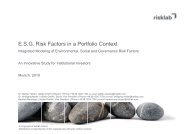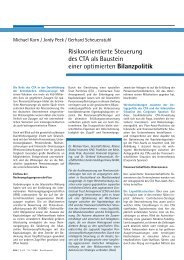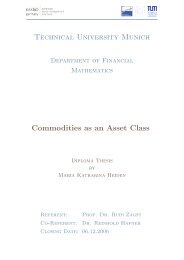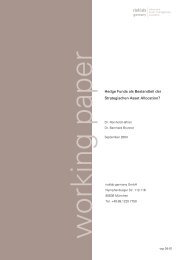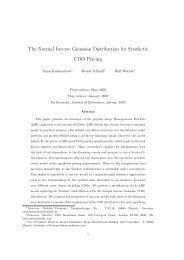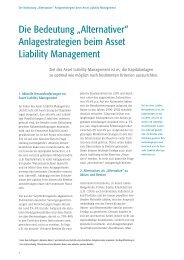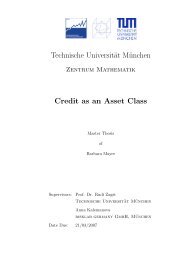Empirical Evaluation of Hybrid Defaultable Bond Pricing ... - risklab
Empirical Evaluation of Hybrid Defaultable Bond Pricing ... - risklab
Empirical Evaluation of Hybrid Defaultable Bond Pricing ... - risklab
You also want an ePaper? Increase the reach of your titles
YUMPU automatically turns print PDFs into web optimized ePapers that Google loves.
2,5<br />
2<br />
1,5<br />
1<br />
0,5<br />
1 Year<br />
3 Years<br />
5 Years<br />
7 Years<br />
10 Years<br />
0<br />
01.10.1993<br />
16.09.1994<br />
01.09.1995<br />
16.08.1996<br />
01.08.1997<br />
17.07.1998<br />
02.07.1999<br />
16.06.2000<br />
01.06.2001<br />
17.05.2002<br />
02.05.2003<br />
Figure 3: 1- To 10-Year Credit Spreads <strong>of</strong> US Industrials BBB1 in %. Time<br />
Period: 1993 — 2003. Source: Bloomberg.<br />
3 The Model <strong>of</strong> Schmid and Zagst<br />
In the following section we give a short overview <strong>of</strong> the Schmid and Zagst<br />
three-factor defaultable term structure model. As a typical hybrid model it<br />
combines elements <strong>of</strong> structural and reduced-form models. The underlying nondefaultable<br />
short rate is assumed to either follow a mean reverting Hull-White<br />
process or a mean-reverting square root process with time-dependent mean reversion<br />
level. Therefore, the dynamics <strong>of</strong> the non-defaultable short rate are<br />
given by the following stochastic differential equation (SDE):<br />
dr (t) =[θ r (t) − a r r (t)] dt + σ r r (t) β dW r (t) , 0 ≤ t ≤ T ∗ , (3)<br />
where a r , σ r > 0 are positive constants, β =0or 1 2 , and θ r is a non—negative<br />
valued deterministic function. This speciÞcation implies that the current rate<br />
r (t) is pulled towards θr(t)<br />
a r<br />
with a speed <strong>of</strong> adjustment a r ,andifβ = 1 2 the<br />
instantaneous variance <strong>of</strong> the change in the rate is proportional to its level.<br />
One <strong>of</strong> the factors that determine the credit spread is the so called uncertainty<br />
index which can be understood as an aggregation <strong>of</strong> all information on the<br />
quality <strong>of</strong> the Þrm currently available: The greater the value <strong>of</strong> the uncertainty<br />
process the lower the quality <strong>of</strong> the Þrm. The uncertainty or signaling process<br />
is assumed to follow a mean reverting square root process. The development <strong>of</strong><br />
8



